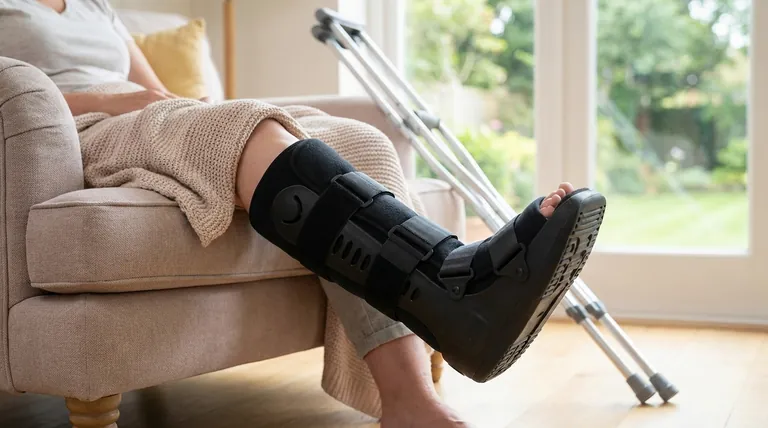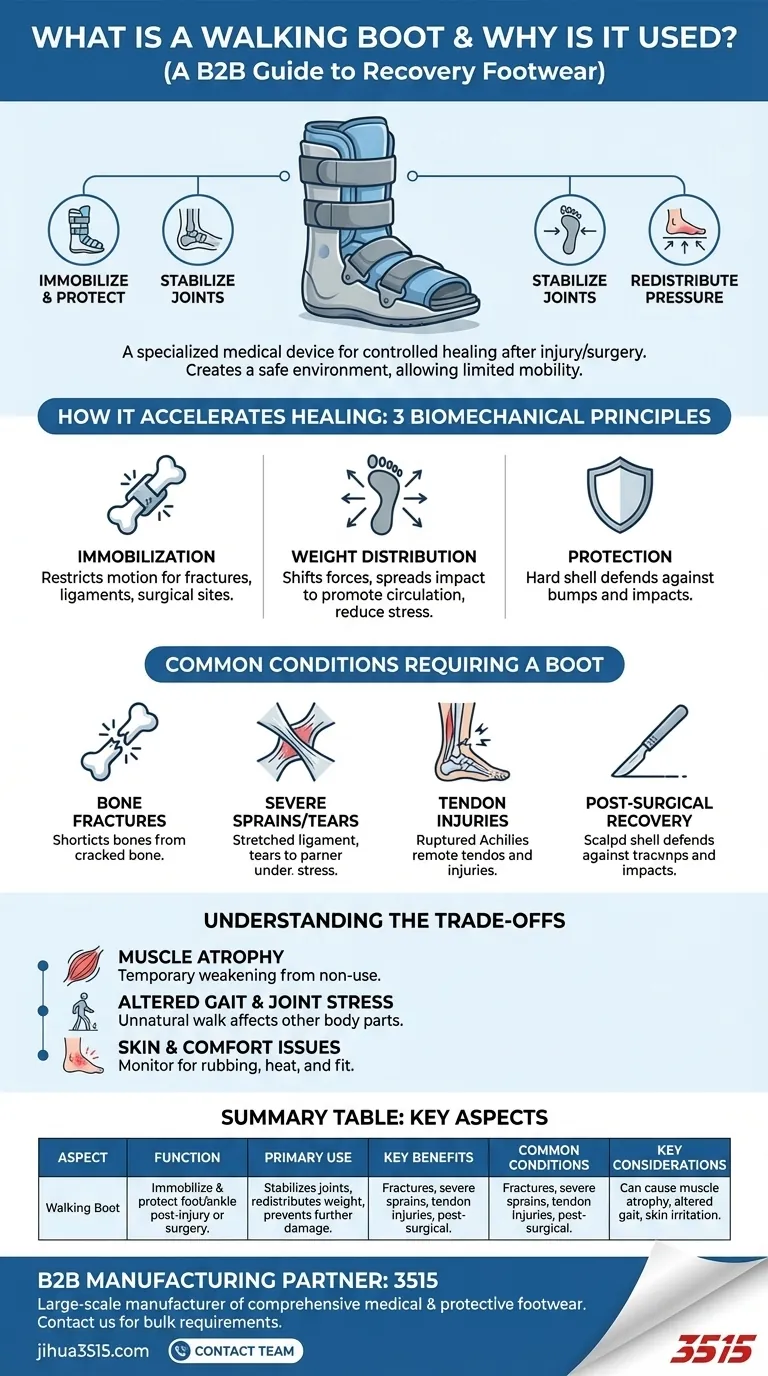A walking boot is a specialized medical device designed to protect your foot and ankle after a significant injury or surgery. It functions by immobilizing the injured area, stabilizing your joints, and redistributing the pressure of your body weight. This controlled environment protects the injury from further damage and allows healing to occur while you maintain limited mobility.
A walking boot creates a controlled environment for healing. By immobilizing the injured area and redistributing pressure, it allows you to remain mobile while preventing movements that could delay or disrupt your recovery.

How a Walking Boot Accelerates Healing
A walking boot is more than just protective footwear; it is an engineered tool that manipulates physical forces to aid your body's natural healing process. Its design is based on several key biomechanical principles.
The Principle of Immobilization
An injured part of the body needs rest to heal. A walking boot's rigid shell and adjustable straps severely restrict the motion of your foot and ankle.
This immobilization is critical for fractured bones to mend, torn ligaments to reattach, and surgical sites to remain undisturbed.
The Science of Weight Distribution
The boot is engineered to shift weight-bearing forces away from the injured area. Its hard exterior and cushioned interior spread the impact of each step across the entire lower leg.
This redistribution allows you to put weight on your leg safely, which can prevent muscle loss and promote better circulation without stressing the injury itself.
Protecting Against Further Damage
The durable outer shell of the boot acts as a shield. It protects your vulnerable foot and ankle from accidental bumps, impacts, or scrapes that could otherwise cause a significant setback in your recovery.
Common Conditions Requiring a Walking Boot
Medical professionals prescribe walking boots for a range of moderate to severe lower leg injuries. While not exhaustive, the most common reasons include:
Bone Fractures
Walking boots are frequently used to stabilize stable fractures of the foot, ankle, or shin bone (tibia), allowing the bones to heal in the correct alignment.
Severe Sprains and Ligament Tears
When ligaments are badly stretched or torn, such as in a severe ankle sprain, a boot provides the stability needed for them to repair without being constantly re-injured.
Tendon Injuries
Conditions like a ruptured Achilles tendon or other significant tendon damage require immobilization to allow the torn fibers to heal and regain strength.
Post-Surgical Recovery
Following many types of foot or ankle surgery, a walking boot is essential to protect the delicate surgical repair work from the stresses of movement and weight-bearing.
Understanding the Trade-offs
While essential for healing, wearing a walking boot is not without its challenges. Understanding these trade-offs is part of managing your recovery effectively.
Muscle Atrophy
Immobilizing your leg for an extended period will inevitably lead to some weakening and loss of muscle mass in your calf. This is a normal side effect that is typically addressed with physical therapy after the boot is removed.
Altered Gait and Joint Stress
Walking in a boot is unnatural. This altered walking pattern (gait) can place new stresses on other parts of your body, particularly the knee, hip, and lower back on both your injured and uninjured sides.
Skin and Comfort Issues
Walking boots can be heavy, cumbersome, and hot. It is crucial to wear appropriate socks and monitor your skin for any signs of rubbing or irritation, as sores can develop if the fit is not correct.
Making the Right Choice for Your Goal
Using a walking boot correctly is key to a successful recovery. Your approach should align with your primary objective under medical guidance.
- If your primary focus is safety and proper healing: Always follow your doctor's instructions precisely regarding wear time and how much weight you are allowed to put on the leg.
- If your primary focus is managing discomfort: Ensure the boot is fitted correctly with all straps snug but not constricting, and wear a tall, non-compressive sock underneath to protect your skin.
- If your primary focus is a full return to function: Be prepared to engage in physical therapy after the boot is no longer needed to rebuild strength, flexibility, and balance in your leg.
Used correctly, a walking boot is a critical tool that bridges the gap between a significant injury and a successful, active recovery.
Summary Table:
| Aspect | Function |
|---|---|
| Primary Use | Immobilize and protect foot/ankle post-injury or surgery. |
| Key Benefits | Stabilizes joints, redistributes weight, prevents further damage. |
| Common Conditions | Fractures, severe sprains, tendon injuries, post-surgical recovery. |
| Key Considerations | Can cause muscle atrophy, altered gait, and skin irritation. |
As a large-scale manufacturer, 3515 produces a comprehensive range of medical and protective footwear for distributors, brand owners, and bulk clients. Our production capabilities encompass all types of specialized boots, including walking boots designed for optimal patient recovery. If you are looking for a reliable manufacturing partner to supply high-quality, durable medical footwear, contact our team today to discuss your specific needs and volume requirements.
Visual Guide

Related Products
- Safety Footwear Wholesale Manufacturer for Custom OEM/ODM Production
- Durable Rubber-Soled Utility Shoes for Wholesale & Custom Brand Manufacturing
- Customizable Anti-Smash Safety Boots for Wholesale & Private Label Manufacturing
- Custom Wholesale Leather Safety Boots Direct Factory Manufacturing
- Premium Wholesale Wheat Nubuck Safety Boot with Rapid Lacing System
People Also Ask
- What are OSHA approved shoes? Understanding the Correct Standards for Workplace Safety
- Do snake bite boots work? Your Ultimate Guide to Effective Snake Bite Protection
- How do safety shoes contribute to cost savings for companies? A Strategic Investment in Risk and Cost Management
- How long can you wear safety boots? The Lifespan is Determined by Wear, Not Time
- What are the differences between steel toe, composite toe, and alloy toe Wellington boots? Choose the Right Safety Toe for Your Job



















